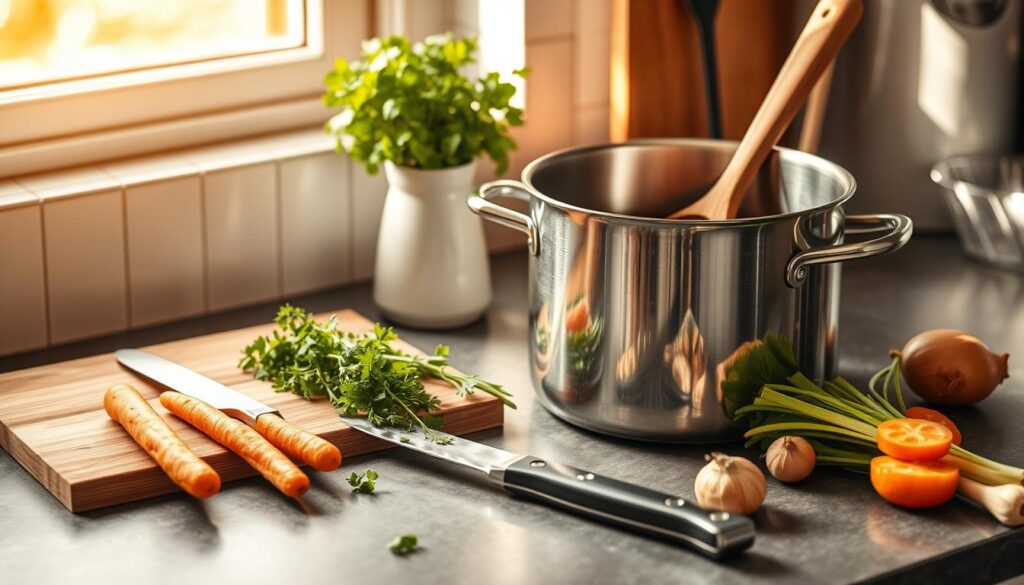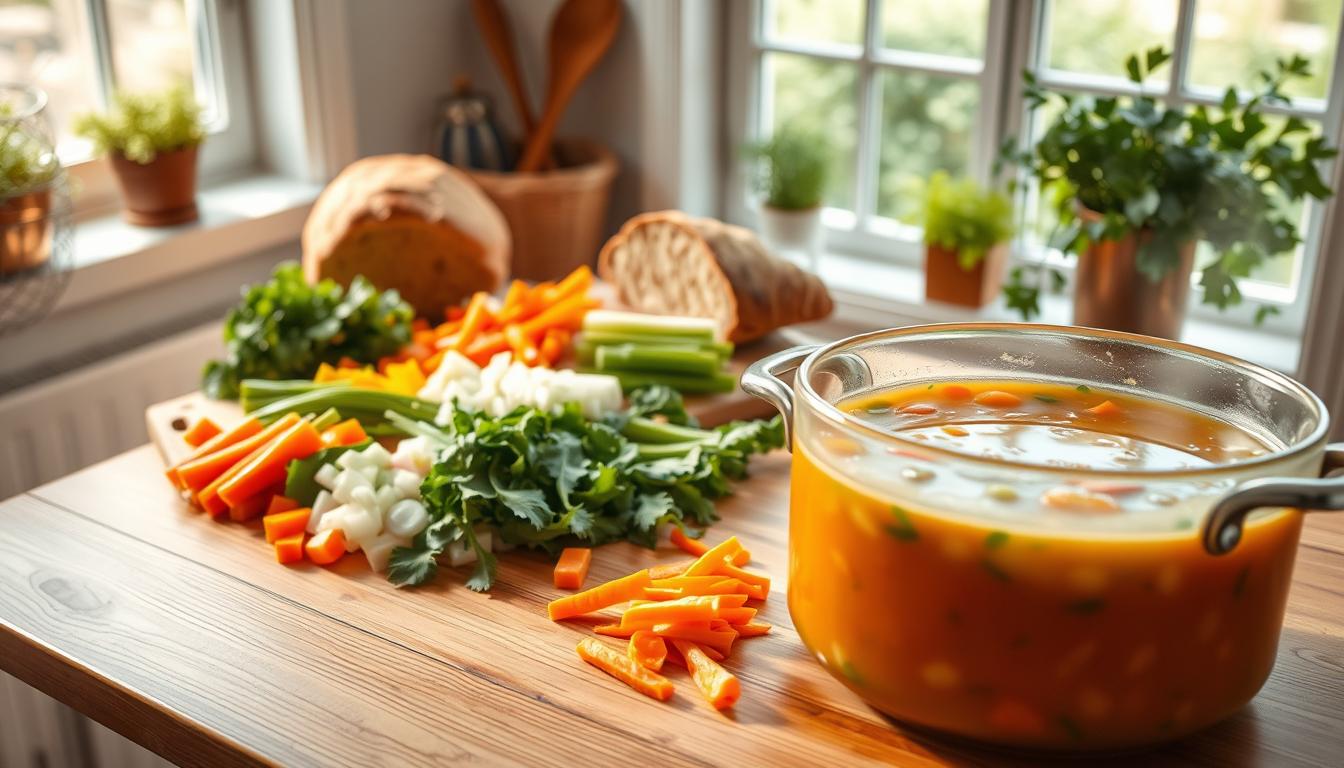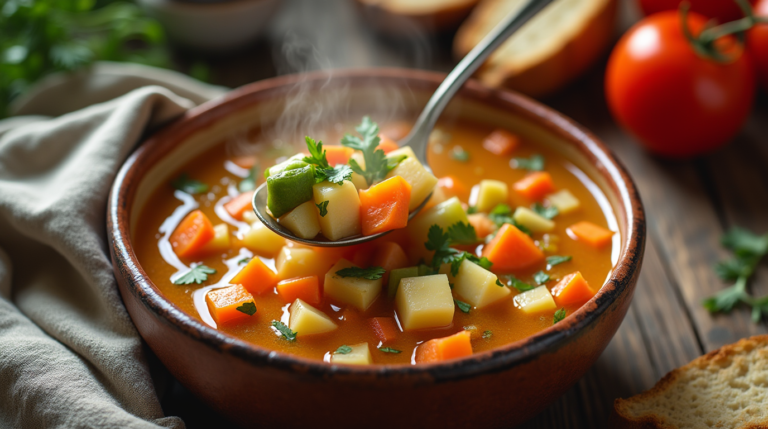Walking into a kitchen filled with the smell of cooking veggies is special. It’s perfect for unwinding after a long day or for a healthy meal that’s easy on your wallet. This article will teach you how to make veg soup that’s both tasty and nutritious.
Picture yourself enjoying a warm bowl of soup made from fresh veggies, herbs, and broth. It’s ready in under an hour. This guide will walk you through each step, making it easy to cook a hearty meal, even if you’re new to the kitchen. No need for complicated techniques here. Just simple tips to make cooking a breeze.
Table of Contents
The Comfort and Convenience of Homemade Vegetable Soup
There’s something special about homemade vegetable soup. It’s more than just a meal; it’s a source of warmth and comfort. It’s perfect for when you’re craving something cozy or need a quick dinner.
Why Vegetable Soup Remains a Popular Comfort Food
“A warm bowl of soup feels like a hug for the soul.”
Vegetable soup is loved across cultures and ages. The smell of simmering ingredients brings back happy memories. Studies show that soup can lower stress and boost mood, making it ideal for cold nights or when you’re not feeling well.
The Time-Savinging Benefits of Making Soup at Home
Making soup is surprisingly quick and easy. Here’s how:
- Cut and toss veggies into one pot.
- Simmer while you do other things.
- Batch cook for lunches all week.
Nutritional Advantages Over Store-Bought Options
Homemade soup beats store-bought in many ways:
- 70% less sodium with fresh ingredients.
- No preservatives or artificial flavors.
- Control over veggies and fats.
Homemade vegetable soup offers nutrition and flexibility. You can adjust recipes to fit your diet, like adding spinach for iron or beans for protein. Every spoonful helps you eat better without losing convenience.
Health Benefits of Including Vegetable Soup in Your Diet
Vegetable soup is more than just a warm meal; it’s a nutritional powerhouse. By choosing healthy soup recipes, you’re boosting your body with vitamins, minerals, and fiber. This easy dish helps you reach your wellness goals without the fuss.
- Hydration: Broth-based soups add water to your diet, keeping you energized.
- Fiber: Veggies like carrots and spinach help digestion and steady blood sugar.
- Immune support: Dark leafy greens and bell peppers pack vitamin C and antioxidants.
- Weight management: Low-calorie soups fill you up, reducing overeating at meals.
Regularly eating vegetable soup can lower inflammation, which is linked to chronic diseases. The variety of veggies in healthy soup recipes ensures you get a range of nutrients. Cooking veggies lightly also helps keep their nutrients, unlike boiling or frying.
Whether you’re meal prepping or recovering from a cold, these soups are perfect. They’re flexible, allowing you to adjust flavors while keeping your diet balanced and healthy.
Essential Ingredients for the Perfect Vegetable Soup
Creating the best vegetable soup starts with picking the right ingredients. Each part is crucial for a balanced, tasty soup. Let’s explore the key ingredients you’ll need.
Base Vegetables That Create Flavor Foundations
Begin with onions, carrots, and celery. These are the flavor base for most soups. Chop them finely to unlock their natural sweetness. Then, sauté until they’re soft. This step is essential for a rich taste.
Seasonal Vegetable Options for Year-Round Soups
| Season | Top Choices |
|---|---|
| Winter | Potatoes, parsnips, butternut squash |
| Spring | Peas, asparagus, fennel |
| Summer | Zucchini, tomatoes, corn |
| Fall | Squash, Brussels sprouts, leeks |
Herbs and Spices That Elevate Your Soup
- Dried thyme or rosemary for earthy notes
- Fresh parsley or cilantro as garnish
- Black pepper for warmth
“For the best vegetable soup recipe, balance dried herbs with a pinch of red pepper flakes for subtle heat,” says Chef Maria Lopez of Green Kitchen Co.
Broth Options: Vegetable, Mushroom, or Water-Based
- Vegetable broth: Adds umami depth
- Mushroom broth: Intense earthy flavor
- Water: Lighter option; add salt for body
Try different ingredients to make a soup that suits your taste and diet. Each choice makes your homemade soup better!
Kitchen Equipment You’ll Need: Keeping It Simple
Making a simple veggie soup doesn’t need fancy tools. A few basic items can help you make a delicious meal, even in a small kitchen. Here’s what you really need:

- A sharp knife and cutting board for prepping veggies
- A large pot with a lid (stainless steel or Dutch ovens work best)
- A ladle or large spoon for stirring and serving
- Basic measuring cups and spoons
Optional upgrades that save time:
| Tool | Use | Optional? |
|---|---|---|
| Immersion blender | Blend soups to desired creaminess | Yes |
| Food processor | Quickly chop large batches of veggies | Yes |
| Microwave-safe bowl | Reheat leftovers easily | Yes |
Choose tools that can do more than one thing. A good knife and cutting board are great for prep all week. If you don’t have a ladle, a large spoon works just fine. Even a colander can help with straining broth.
Look for starter sets at stores like Walmart or Target for under $25. Start with what you have. The aim is to make your simple veggie soup easy, not perfect. You can add more tools over time.
How to Make Veg Soup: Step-by-Step Instructions
Learning how to make veg soup is all about following the right steps. This guide will help you make a delicious meal from fresh ingredients.
Preparing Your Vegetables Properly
Start by washing all your veggies well. Cut hard veggies like carrots and potatoes into ½-inch cubes. Tear soft greens like spinach or kale instead of cutting them.
Use a sharp knife and a stable cutting board for even cuts. Remember, prep all your veggies before you start cooking.
Creating a Flavorful Base
Heat some olive oil in a big pot over medium heat. Cook chopped onions, garlic, and celery until they’re soft. This is the base of your soup.
Stir them often to prevent burning. Add a bay leaf or some dried thyme to deepen the flavor.
Adding Ingredients in the Right Order
- Put cubed potatoes and carrots in first—they take longer to cook.
- Pour in broth or water, then simmer uncovered until they’re tender.
- Add quick-cooking veggies like zucchini or corn. Simmer for 5 more minutes.
- Finally, add greens like spinach at the end to keep them fresh.
Simmering Techniques for Maximum Flavor
Simmer uncovered on low heat to blend flavors without overcooking. Stir now and then with a wooden spoon to prevent sticking.
Taste and adjust the seasoning with salt, pepper, or lemon juice. If it’s too salty, add a diced potato to soak up the excess.
By following these steps, you’ll enjoy a homemade veg soup that’s both nutritious and tasty. It’s perfect for busy weeknights or meal prep!
Quick Vegetable Soup Variations to Try
Ready to make your vegetarian soup recipe new again? Try these simple changes to turn a basic soup into something exciting. Add new textures or bold flavors to suit your taste.
Creamy Texture Twists
Add richness without making it complicated:
- Swap broth for coconut milk or cashew cream for a plant-based boost.
- Blend half the soup for a silky base, or stir in silken tofu for a creamy finish.
- Whisk in heavy cream slowly to prevent curdling—1/2 cup at a time works best.
Spicy Heat Levels
Customize the heat to your liking:
- Mild: Sprinkle black pepper or smoked paprika.
- Medium: Stir in red pepper flakes or a dash of harissa paste.
- Hot: Finely chop Thai chilies or add a few drops of hot sauce at serving.
Global Flavors
Try these flavor combinations:
- Italian: Simmer with basil, sun-dried tomatoes, and a Parmesan sprinkle.
- Mexican: Add cumin, chili powder, and a lime wedge garnish.
- Thai: Combine coconut milk, lemongrass, and red curry paste.
- Indian: Mix turmeric, garam masala, and a dash of coconut milk.
Pair these ideas with your favorite veggies for endless combinations. Adjust spices to taste and store extras for quick meals!
Storage Tips and Reheating Your Homemade Vegetable Soup
Keeping your homemade vegetable soup fresh and flavorful is key. Proper storage helps maintain its taste, whether you’re saving leftovers or freezing them for later. Here’s how to keep your easy vegetable soup delicious for a long time.
Freezing Portions for Future Meals
Start by cooling the soup quickly. Let it sit at room temperature for no more than two hours before refrigerating or freezing. For freezing:
- Use airtight containers or freezer-safe bags, leaving headspace for expansion.
- Portion into single servings for quick defrosting.
- Label with dates and contents.
- Keep in the freezer up to 3 months for best quality.
How to Refresh Leftover Soup
If your soup thickens or loses its vibrancy, try these tricks:
- Stir in fresh herbs like parsley or cilantro.
- Add a squeeze of lemon or lime juice.
- Mix in chopped veggies like spinach or corn.
“A squeeze of citrus or a handful of fresh herbs can revive even the blandest leftovers.” – Sarah Green, Culinary Nutritionist
Reheat small portions gently on the stove or in the microwave, adding water if needed. With these steps, your easy vegetable soup becomes a go-to for busy days or cozy nights.
Pairing Suggestions: What to Serve with Your Vegetable Soup
Once your quick vegetable soup recipe is ready, think about what to pair it with. Crusty bread or warm rolls are great for soaking up the broth. A slice of garlic bread or a cheesy cracker adds a nice salty taste. For a lighter option, try a side salad with a tangy vinaigrette.

Adding protein to your soup makes it a full meal. Here are some easy options:
- Hard-boiled eggs for a protein boost
- Grilled cheese sandwiches for comfort food harmony
- Roasted chickpeas or nuts for crunch
| Protein Option | Prep Time | Serving Tip |
|---|---|---|
| Grilled chicken strips | 15 mins | Serve on the side for dipping |
| Shaved Parmesan | 0 mins | Offer as a sprinkle topping |
| Hard-boiled eggs | 10 mins | Cut into wedges for easy picking |
Finish with garnishes like fresh herbs or a drizzle of olive oil. This adds brightness to your meal. For a party, set up bowls with spoons and warm bread. Leftover soup? Pair it with a green salad for a light lunch. These ideas make your quick vegetable soup recipe special without extra work. Every bite is a balanced experience, all without complicated planning!
Conclusion: Enjoying the Rewards of Your Homemade Vegetable Soup
Homemade vegetable soup is more than just a meal. It’s a healthy choice that fits any lifestyle. By making it yourself, you choose every ingredient. This ensures a dish full of vitamins and no additives.
This simple dish also saves money. It’s cheaper than buying it from the store. Plus, it’s easy to use seasonal produce or follow dietary preferences. Every pot you make is a step towards healthier eating without losing flavor.
Adding homemade vegetable soup to your routine can change meal planning. Cook a big batch on weekends for quick dinners or leftovers. Even small changes, like swapping herbs or adding grains, let you try new flavors.
Over time, your soup will reflect your tastes. You might like bold spices or mild, creamy textures. It’s a dish that grows with you.
Start with the basics and then tweak ingredients to match your cravings. It’s a dish that grows with you. Try local vegetables, new seasonings, or add proteins like lentils for extra protein. Every bowl you serve shows your creativity and care, making it a family favorite.
So, grab your pot and start your culinary journey. Enjoy one flavorful spoonful at a time.







